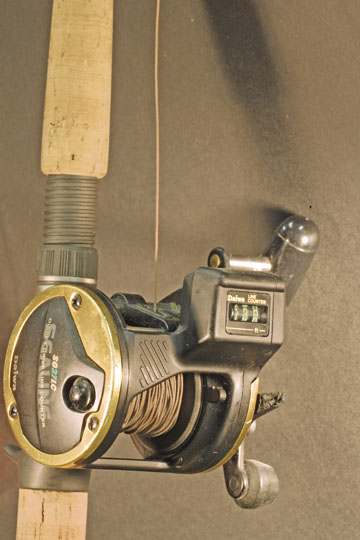Fishing with leadcore line
Ever since leadcore line hit the market, anglers have searched for a reliable formula to determine depth

Fishing for walleyes with leadcore line has really come into its own in recent seasons.
Once the bastion of coldwater anglers who use this weighted-line technique to reach deep-loving trout, kokanee and salmon, leadcore line can be an equally effective tool for reaching deep walleyes. Best of all, leadcore allows you to fish completely unencumbered by such extraneous devices as downriggers or divers. And while you can add sinkers to reach even deeper, oftentimes just the leadcore is more than enough.
Leadcore is a thin, soft, pliable, round “core” of lead – or an environmentally friendly lead substitute – that’s wrapped in an outer Dacron or nylon skirting. It’s usually sold in spools of 100 yards, although 200-yard spools are also available. Leadcore is colored in increments of 10 yards. To pay out “four colors” is to let out 40 yards, or 120 feet, of line.
Ever since leadcore hit the market many decades ago, anglers have been trying to find a reliable formula for figuring out how much leadcore it takes to reach a predetermined depth. A favorite, albeit rough, approximation is that leadcore will sink 5 feet for each color that’s released. But there are far too many variables for this to be scientific. Wind speed, trolling speed, water temperature and resulting density, lure weight, and leader length are all factors that influence how much depth your leadcore line is actually achieving.
Another, perhaps more accurate, formula is three colors out equals 15 feet; five colors equals 25 feet; eight colors equals 30 feet; and nine colors equals 35 feet.
Another factor is the thermocline on stratified lakes. Once leadcore hits that thermocline, it tends to “flatten” out, not sinking beyond the thermocline. Of course, if your fish are right in the thermocline, you’re in business.
Leadcore is best spooled on an oversized bait-casting reel using Dacron backing – the same stuff as fly-fishing line backing. Leadcore doesn’t stretch, similar to braided line, so a lengthy rod with some flex to it, like a light- to medium-action 7-footer or longer to absorb the shock of the strike, is a favorite rig of trout anglers, and works well for walleyes, too, with a nod toward a more medium-action for bigger water and bigger fish.
Leadcore is very visible in the water, which can be a problem when you’re fishing clear water or nearly clear water. The solution is to add a fluorocarbon leader; the clearer the water, the longer the leader. Leaders can be attached to leadcore with a nail knot, considered the best; surgeon’s loop/cinch knot; overhand knot/cinch knot; or by way of a small swivel. The knot you use generally depends on the amount of space you have in the opening of your bait-casting reel and rod guides, since that knot has to come in and out easily when you’re releasing or retrieving line.
As with other types of fishing lines, leadcore comes in a variety of breaking strengths, ranging from 12-pound-test up to 45-pound-test. The lower pound-tests have thinner lead and sink less than the upper pound-test lines. A 15-pound-test leadcore line will sink less than a 30-pound-test leadcore line, for example.
Leadcore’s most beneficial quality is its ability to sink and achieve depth while you’re trolling without having to resort to heavy weights, divers or downriggers. It can be an ideal choice for fishing suspended walleyes or for getting close to the bottom.
You can troll crankbaits on leadcore, which helps the line dive even deeper. Another good, if not excellent, choice is trolling suspending stickbaits on leadcore, like a Cultiva Rip’n Minnow, a Lucky Craft BevyShad, a Flash Minnow or a Pointer 100.
Suspending stickbaits work well on leadcore because you can use a very long leader – 25 to 45 feet – and stop and start your trolling, with the bait suspending enticingly when you stop. Leadcore can also be used for worm harnesses and for pulling a flasher attractor, like a Mack’s Lure Hot Wings.